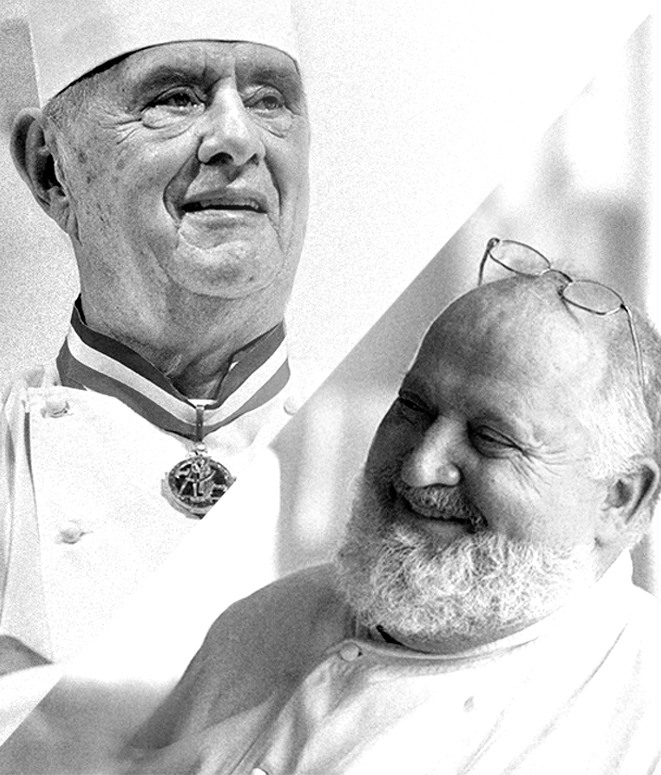Cooking is one of the ways we pass on traditions and cement a sense of community—and it’s the same for your fermentation-obsessed friend as it is for Michelin-starred chefs.
To our great sadness, Sous-Vide lost two friends and culinary luminaries: Michel Richard of Central and Citronelle, who passed away in 2016, and Paul Bocuse, of L’Auberge du Pont de Collonges and Bocuse d’Or, who passed away this past January. We’ll miss their talent, but mostly, we’ll miss sharing a meal with them.
Though they had unique culinary visions, both of these extraordinary chefs valued precision and technique highly. To celebrate that dedication, we’re spotlighting our memories of their greatest lessons.
Michel Richard, the Big-Picture Artist
The Chef:
Michel Richard, who inspired the Tuna and Compressed Watermelon Salad in Sous-Vide’s latest issue, was a serious chef who indulged a bit of whimsy, too. Though most of his career was spent in restaurants, his training as a pastry chef laid the foundation for his approach.
“His mind was different than that of other cooks. He weighed everything and he was a very technical chef,” says Cuisine Solutions Executive Chef Bruno Bertin, who worked with Richard on food innovations. “So much advanced technique—imagine a seven-inch-diameter sausage casing. He’d put pastry dough inside, cook it, and slice it in a slicer to get the same exact ring to make flatbreads.”
The Dish:
Richard’s imagination enabled him to riff on traditional cooking styles, and it helped him enchant diners with illusory presentation. Case in point: His nicoise salad.
“It had a perfect hard boiled egg, then when you tasted it, it was mozzarella and the yolk was a reduction of yellow heirloom tomatoes,” Bertin remembers. “It was incredible—amazing flavor. It was trompe-l’œil.”
The Lesson:
If you can dream up a mozzarella-tomato egg, you can cook it—as long as you never abandon your fundamentals. Richard taught chefs that technical precision and imagination aren’t mutually exclusive in cooking. If you nurture the former, the latter will flourish.
Paul Bocuse, the Guardian of Technique
The Chef:
Paul Bocuse was at the forefront of nouvelle cuisine, a movement that took classic French dishes and spun them with lighter flavors, unexpected combinations, and artful presentations. “There is no one like him right now in the cooking world,” says Bertin.
Over the course of his career, his dedication to mastering and refining French techniques earned him Michelin stars and even a French Legion of Honor. Like Richard, he championed the idea that chefs who respect the basics can ultimately transcend them. He even founded a culinary school and published the leading tome on French gastronomy to disseminate that idea.
The Dish:
Complex in flavor, but not fussy. Traditionally French, but totally unprecedented. Bocuse’s truffle soup, first served in the ‘70s at the Élysée Palace, was the epitome of nouvelle cooking.
“It was that famous truffle soup that was covered with that puff pastry. When you broke the crust, the scent of truffle would escape from beneath the pastry and rise up in steam that would meet your face,” Bertin remembers. “That was 30 years ago, and I can still recall it.”
The Lesson:
Though Bocuse was perhaps the first of the modern celebrity chefs, the way he cooked was anything but superficial—always making sauces, seasoning, sous-viding the right way, not the fast way.
“He cooked without shortcuts, with the full respect of technique. Because he did this, the cuisine got even more molecular,” says Bertin. “When you look at his recipes, he just hammered and hammered like steel to make sure it was perfect.”
Buy the Magazine
Buy NowDedicated to the Art & Science of Sous Vide
The first publication devoted to the art and science of sous vide cooking, featuring innovative recipes, visual inspiration, expert techniques for cooking sous vide at home, and exclusive interviews with world-class chefs.

